|
January 11, 2004
I hear Spanish, but I don’t understand a single
word. This is trouble…I’m only in the Dallas
airport getting a piece of pizza, what am I going to
do when we actually get to Mexico?
We passed trip’s first test back home in Chicago.
Surprisingly, our bags were within the weight limit.
As I step on to the plane in Dallas, I watch my freakishly
large duffel bag roll down the conveyor. Another good
sign. All I want to do is get through the Mexico City
airport and on to Puebla. As usual for me before any
big trip I’ve got another headache. Stress!
 The
plane arcs towards the runway and through the haze we
can begin to see Mexico City. Navigating through the
terminal and past the drivers offering us rides, we
make it quickly to the bus stop. Nervously using my
Spanglish, I ask the man behind the hazy window, “Dos
boletos para Puebla, por favor?” 125 pesos and
an hour later we’re riding in comfort on the Estrella
Roja express bus, watching Close Encounters of the Third
Kind dubbed in Spanish while a woman strolls the aisles
feeding us unidentifiable pastries and warm soda. Our
first hour and Randy has taken a picture of everything
already. Mexico City is enormous. The sights, the smells,
the people. Green VW beetle taxis tear through the streets.
Next stop, Puebla. The
plane arcs towards the runway and through the haze we
can begin to see Mexico City. Navigating through the
terminal and past the drivers offering us rides, we
make it quickly to the bus stop. Nervously using my
Spanglish, I ask the man behind the hazy window, “Dos
boletos para Puebla, por favor?” 125 pesos and
an hour later we’re riding in comfort on the Estrella
Roja express bus, watching Close Encounters of the Third
Kind dubbed in Spanish while a woman strolls the aisles
feeding us unidentifiable pastries and warm soda. Our
first hour and Randy has taken a picture of everything
already. Mexico City is enormous. The sights, the smells,
the people. Green VW beetle taxis tear through the streets.
Next stop, Puebla.
January 12, 2004
 Randy
and I excitedly wake up at 5 am to the sounds of motorcycles
in the streets and went to the rooftop garden to catch
the sunrise. La Malinche to the North, Popo and Izta
to the West, and Pico de Orizaba to the East. Foreign
travel is new to both us and I can tell Mexico is going
to be quite an experience. Poverty and people everywhere,
but you wouldn’t know from the inside of Hotel
Colonial, a former monastery built in the 15th century. Randy
and I excitedly wake up at 5 am to the sounds of motorcycles
in the streets and went to the rooftop garden to catch
the sunrise. La Malinche to the North, Popo and Izta
to the West, and Pico de Orizaba to the East. Foreign
travel is new to both us and I can tell Mexico is going
to be quite an experience. Poverty and people everywhere,
but you wouldn’t know from the inside of Hotel
Colonial, a former monastery built in the 15th century.
After breakfast of huevos rancheros (with black bean
salsa), hot chocolate milk (scalded milk, actually)
and toasts (yes, with an “s”) we hopped in
a taxi for a thrill ride to the huge Puebla bus station,
CAPU. Traffic laws mean nothing. Speed limits are merely
suggestions as we’re easily three times over the
posted numbers. People had better stay on the sidewalk
if they know what’s good for them.
 CAPU
is an enormous place the size of many airports, with
literally hundreds of busses. Without question, the
bus is the preferred method of transportation in Mexico.
Efficient, clean, comfortable, so far. I’m quite
proud of myself when I speak with the ticket agents
in Spanish and figure out the schedules for the remainder
of the trip. Our first destination is a small town named
Apizaco on the route to La Malinche. CAPU
is an enormous place the size of many airports, with
literally hundreds of busses. Without question, the
bus is the preferred method of transportation in Mexico.
Efficient, clean, comfortable, so far. I’m quite
proud of myself when I speak with the ticket agents
in Spanish and figure out the schedules for the remainder
of the trip. Our first destination is a small town named
Apizaco on the route to La Malinche.
On the way to Apizaco, the bus stops every few miles
to let others on and off. A man with a guitar gets on
and sings an out-of-key tune then roams the aisles looking
for coins. A woman selling bread gets on as he exits
at the next roadside stop. I spot a man standing by
the side of the expressway in his underwear, washing
his hair in a mud puddle. The large windows give us
a completely cloud free view of Popo and Izta.
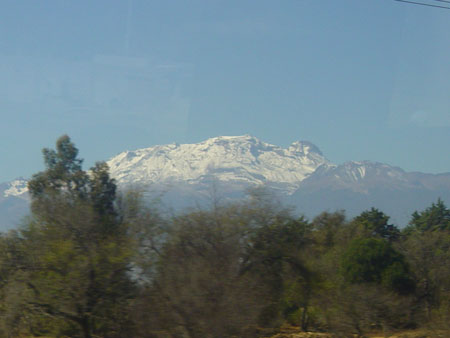 As
impressed as I am with the mountains, I marvel at the
incredible array of life passing the bus windows. I’ve
seen more police in the 18 hours since we’ve landed
than I would see in years at home. There are two dogs
for every person, but no one seems to own them. I just
saw a van with IL plates. Clothing hangs on all of the
buildings and I realize what a sheltered life we lead.
How do all these roadside fruit, lemonade and tortilla
stands survive? Despite the dirt and poverty, it’s
fascinating and I love it. As
impressed as I am with the mountains, I marvel at the
incredible array of life passing the bus windows. I’ve
seen more police in the 18 hours since we’ve landed
than I would see in years at home. There are two dogs
for every person, but no one seems to own them. I just
saw a van with IL plates. Clothing hangs on all of the
buildings and I realize what a sheltered life we lead.
How do all these roadside fruit, lemonade and tortilla
stands survive? Despite the dirt and poverty, it’s
fascinating and I love it.
We arrive in Apizaco at 10 am. As we get our gear,
all the taxis, or Colectivos as they are called here,
immediately disappear as the locals snatch them up.
The station attendant gives us cryptic instructions
to walk 8 blocks into town to find the right bus. Weaving
our way through packed sidewalks and literally hundreds,
if not thousands of six foot wide shops selling clothing,
tortillas, candy, medicine, and household appliances,
we finally reach what we think is the right spot. A
shopkeeper eyes our bags and decides we’re headed
for LaMalinche. Una hora, once y media. One hour, 1:30.
We wait.
 We
arrive at the camp and find that a group of 11 students
and teachers from Prescott College in Arizona have just
come down from the summit as we’ve arrived. Perfect
timing…We’ll ask them to watch our gear as
we climb. We head for La Malinche, 4600 feet above our
camp at 10,000 at 1:15. It’s a straight forward,
no navigation hike up a well worn path. The forest looks
like any other pine forest anywhere in the US. The one
difference is the trash; piles of it, candy wrappers,
empty water bottles, tissues, and 3 liter coke bottles
seem to be the garbage of choice. We
arrive at the camp and find that a group of 11 students
and teachers from Prescott College in Arizona have just
come down from the summit as we’ve arrived. Perfect
timing…We’ll ask them to watch our gear as
we climb. We head for La Malinche, 4600 feet above our
camp at 10,000 at 1:15. It’s a straight forward,
no navigation hike up a well worn path. The forest looks
like any other pine forest anywhere in the US. The one
difference is the trash; piles of it, candy wrappers,
empty water bottles, tissues, and 3 liter coke bottles
seem to be the garbage of choice.
I’m feeling great today. No headaches and I’m
climbing strong. We break tree line at about 12,500
and are faced with the crux of the climb, an 800 feet
scree slope to the ridge above. Each step up takes up
½ step back and fills our shoes with volcanic
ash.
Reaching the ridge we are greeted with views of Izta
and Popo with its perfect, symmetrical cone rising above
the clouds. We’re both feeling the altitude as
we approach 14,000. We ascend the final boulder field
to gain the 14,640 summit. It is a magnificent view
of all the volcanoes. Peeking over the ridge next to
us is astounding, eyeing the drop several thousand feet
into this long-extinct volcano’s ancient caldera.
It’s the highest point for either Randy or I to
date and its Randy’s first summit ever. At this
height we are nearly 200 feet above any part in the
lower 48 and this is only the warm up.
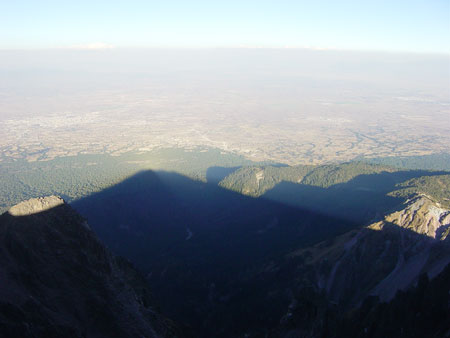 We
set a quick pace on the way up reaching the top in less
than four hours. I’ll set an even faster one on
the way down reaching the bottom in an hour and a half. We
set a quick pace on the way up reaching the top in less
than four hours. I’ll set an even faster one on
the way down reaching the bottom in an hour and a half.
January 13, 2004
Our campsite at Centro Vacacional de La Malintzin is
a nice quiet place if you don’t mind dogs. Not
the well trained sort that you see in the park catching
frizbees, but strays numbering a dozen or more. Seven
of them followed the other group to the summit, apparently
leading the way like their own personal guides. These
dogs barked throughout the night. Sometimes at I’d
guess they were barking at something meaningful, but
mostly at their own echoes. Between the dogs, my general
inability to find a comfortable spot and the fact that
I’ve had to pee all night but don’t want to
go out in the cold, I spend the night tossing and turning
and barely sleeping, never for more than a few minutes
at a time.
The group of students decides to catch the 9am Colectivo
too and we’re nervous that we won’t fit. The
driver, Hermando pulls up in his shiny white VW minibus
asks “how many” and upon hearing there’s
13 plus all our gear, he promptly replies “Ay,
no problema”
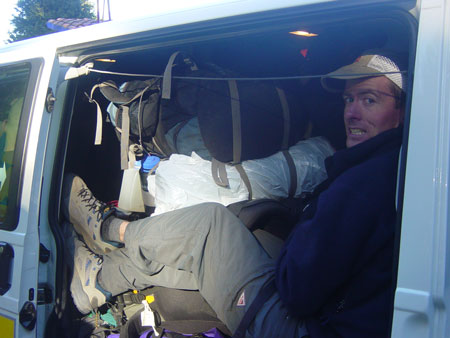 Back
in Apizaco we catch the 10:30 bus back to Puebla. We’re
treated once again to another American movie dubbed
in Spanish. I try to write but the bumping of the bus
makes it impossible. I was able to reach Kellie back
in Apizaco. I’d like to call more frequently to
let her know I’m OK. She said Rachael’s been
crying and I feel bad. I just want to talk to her and
let her know I’m OK. Our plan is to go to Tlachichuca
today and onto Piedra Grante, where I won’t be
able to call for two days. I’m hoping we’ll
arrive with enough time in Tlachichuca so I can call
home again. Back
in Apizaco we catch the 10:30 bus back to Puebla. We’re
treated once again to another American movie dubbed
in Spanish. I try to write but the bumping of the bus
makes it impossible. I was able to reach Kellie back
in Apizaco. I’d like to call more frequently to
let her know I’m OK. She said Rachael’s been
crying and I feel bad. I just want to talk to her and
let her know I’m OK. Our plan is to go to Tlachichuca
today and onto Piedra Grante, where I won’t be
able to call for two days. I’m hoping we’ll
arrive with enough time in Tlachichuca so I can call
home again.
Back in Puebla’s CAPU station, we buy our tickets
to and spend the next 10 minutes trying to locate the
correct gate. After a long and confusing walk, we finally
reach the gate. The bus leaves in 30 minutes so we decide
to eat something that’s not freeze dried and Church’s
chicken is just the right treat.
Our next bus is an “intermedio” bus. Apparently
that means “bus that stops whenever somebody wants
to get on to sell you crazy looking drinks and pastries.”
We arrive safely in Tlachichuca and quickly found Hotel
Gerar and load into his rusty, ailing 1970’s Jeep
Cherokee to El Refugio at 14,000 feet. I was happy to
find a phone on our way out of town so I could call
Rachael. Unfortunately she was staying late at school.
I’ll call back in 2 days when we return from Pico
de Orizaba.
Gerardo speaks almost no English, but he understands
my butchering of his language and seems pleased to meet
a climber who wants to learn his language. He asks me
how to say things in English as I do the same in Spanish.
Randy quietly rides in the back, snapping pictures.
 We
reached El Refugio at 5:30. The crowd is light, with
one group of 7 from Montana and a couple from Indiana
and New Jersey. We
reached El Refugio at 5:30. The crowd is light, with
one group of 7 from Montana and a couple from Indiana
and New Jersey.
January 14, 2004
Well, I made it through the night without freaking
out about mice. In fact, I slept better then at La Malinche.
I could hear them in the walls and scurrying around
on the floor though.
Randy and I take the first of our acclimatization hikes
to 15,200 today. The first thousand feet from the Refugio
climbs up a steep and twisted trail. On this first hike,
I’m concerned about how prepared we are, both in
terms of gear, physical readiness, and hard skills.
The other guys in the cabin are extremely experienced
and they’re going to move very quickly so we’ll
be left to find the route on our own. One guy went to
the glacier and is describing it right now and he’s
making it sound much more difficult then I expected.
He’s talking about class 4 icy scrambles and “a
labyrinth”. Compound all this with the fact that
we’ll be doing it in the dark. We’ll turn
back if this not safe and we don’t feel confident.
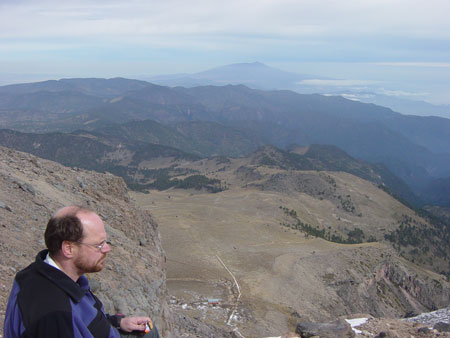 Some
of this is probably my own self-doubt speaking, but
some is also truth. I’m glad that we’re here
attempting this mountain because it’s giving me
a better idea of my skills and shortcomings. What I’m
really concerned about though is Randy. He was really
struggling on today’s hike to just over 15,000
ft. Even if we don’t summit, I’d like to at
least make a strong try. Some
of this is probably my own self-doubt speaking, but
some is also truth. I’m glad that we’re here
attempting this mountain because it’s giving me
a better idea of my skills and shortcomings. What I’m
really concerned about though is Randy. He was really
struggling on today’s hike to just over 15,000
ft. Even if we don’t summit, I’d like to at
least make a strong try.
January 15, 2004
Midnight arrives quickly on my third nearly sleepless
night in a row. Tonight was less about the mice scurrying
around by my head and more about nervousness for the
climb. Are we ready? What will I do if Randy can’t
go on? The others in the hut are not too friendly and
don’t seem too willing to let us or me, come along
with them. I can’t blame them though. They don’t
know us and the last thing they need is to prepare only
to have an unknown in the mix.
Randy and I hit the trail at 12:20. It’s a warm
evening, probably 50 degrees or so. As we begin, he’s
laboring hard behind me. I ask how he’s doing and
he gives an unconvincing “ok”. The moment
I’ve been expecting occurs just minutes into the
climb he asks me to stop and says, “We have a decision
to make”. He says he won’t be able to make
it to the top with his pack. We talk about redistributing
our load for a minute and decide instead that our choice
is to either continue and see how far we can go, but
give up our chance at Izta, or stop now and save his
strength for Izta. I choose to cut our losses on Orizaba,
however disappointing it is. Inside, I am hurt and my
heart is disappointed. I was really looking forward
to the idea of having reached the summit of the 3rd
highest peak in North America.
My head says it’s the right decision though. Part
of me is scared of this mountain. Fear of the mountain
is good because it can kill you. The crosses in memory
of climbers who have lost their lives here are a reminder
that this is high altitude mountaineering and is not
to be taken lightly. Still, my fear pisses me off. I’m
a better climber a smarter climber than my fear suggests.
Maybe it’s because every account that I read on
the internet seems to have anyone who attempts the mountain
reach the top. Maybe it’s because I see the two
gumbies in the other group, one in particular, who doesn’t
know how to self-arrest or even hold an ice axe. I’m
no expert, but I have more of a right to make a legitimate
summit bid. Maybe it’s the small size of our group
and wanting the security of others. Having at least
3 would have allowed Randy to bail out without having
the same climb-ending effect on me. I am both disappointed
and relieved I’ll just have to come back.
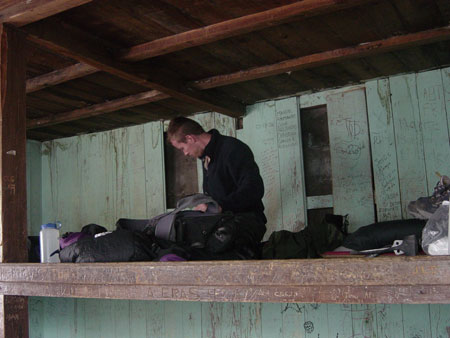 Back
in the hut I lay awake as mice crawl over my sleeping
bag attempting to steal anything they can grab. Sunrise
comes not a moment too soon and there’s finally
a reason to get out of my sleeping bag. I step outside
and suddenly realize that it’s colder now then
it was at midnight. I scan the glacier 2000 feet above
us with the binoculars, looking for any sign of climbers.
We hear the reports over the radio and learn that the
two strongest climbers have failed to reach the summit.
Mike, who has climbed all over the world, is soloing
the mountain, having started this morning from camp
2 at 15, 600. His chosen route the recommended route
took him to a large bergschrund, 50 feet deep and it
scared him off the mountain. This was his third attempt
on the mountain. It’s that kind of solid judgment
that will allow him to come back a 4th time. On his
descent he told the other group about the barrier and
they quickly re-routed to the right side of the glacier.
I still don’t understand why he didn’t go
up the right side with them and instead chose to return.
He was so close. Back
in the hut I lay awake as mice crawl over my sleeping
bag attempting to steal anything they can grab. Sunrise
comes not a moment too soon and there’s finally
a reason to get out of my sleeping bag. I step outside
and suddenly realize that it’s colder now then
it was at midnight. I scan the glacier 2000 feet above
us with the binoculars, looking for any sign of climbers.
We hear the reports over the radio and learn that the
two strongest climbers have failed to reach the summit.
Mike, who has climbed all over the world, is soloing
the mountain, having started this morning from camp
2 at 15, 600. His chosen route the recommended route
took him to a large bergschrund, 50 feet deep and it
scared him off the mountain. This was his third attempt
on the mountain. It’s that kind of solid judgment
that will allow him to come back a 4th time. On his
descent he told the other group about the barrier and
they quickly re-routed to the right side of the glacier.
I still don’t understand why he didn’t go
up the right side with them and instead chose to return.
He was so close.
By the end of the day, only 4 of the 8 who reached
the glacier will summit. Strangely enough, it’s
not the group I expected. The stronger, more experienced
climbers succumb to altitude sickness and exhaustion
while the fat slow goof who doesn’t know his axe
from his ass reaches the top. When he returns he says
that the only reason he kept going up the glacier was
that he was too afraid to go down.
Senor Reyes picks them up at 2pm and drops off two
college students from Arizona. Talk about massively
unprepared. These two women have no idea what they’re
in for. One is fairly experienced having done several
volcanoes in the Northwest USA. The other is just along
for the ride. She bought a pair of hiking boots in Mexico
City just for this trip. So far they’ve gotten
snowed off LaMalinche, sick on Izta and now they’re
here…alone. They’ll be climbing alone with
nobody else on the mountain to give them information
or help with the inevitable rescue if they go too high.
I call Kellie and it’s quite a relief to hear
her voice. I finally get to talk with Rachael too. My
adventuring seems to be wearing on Kellie though, making
me more anxious to get home. She’ll never really
know how much I appreciate her putting up with my stuff.
Few people would be as giving. I wish I could have the
entire family join me on a trip like this. It’s
an incredible cultural experience.
 On
our way back to the hotel, we stop at the “minimercado”
to buy groceries. We’re tired of freeze dried food,
especially after watching the other climbers eat the
ton of locally purchased food that they brought to Piedra
Grande. We also make a quick stop at an internet café
so we can send a few e-mails home. The kids are staring
and giggling with each other at the sight of the odd
Americans. On
our way back to the hotel, we stop at the “minimercado”
to buy groceries. We’re tired of freeze dried food,
especially after watching the other climbers eat the
ton of locally purchased food that they brought to Piedra
Grande. We also make a quick stop at an internet café
so we can send a few e-mails home. The kids are staring
and giggling with each other at the sight of the odd
Americans.
January 16, 2004
As the bus gets closer to Puebla, the clouds grow thicker.
Izta and Popo are completely obscured. Definitely a
bad sign for our planned ascent tomorrow morning. We
may need to use that extra day after all. The weather
has cooperated so far, but today things may change.
I purchase our tickets for the next bus that will take
us to Amecameca in a roundabout sort of way. The bus
is headed to Mexico City’s TAPO bus station, but
makes stops along the way. The only problem was that
I don’t exactly know where our stop, Puente de
Chalco, is and they don’t make any announcements
on the bus about each stop. On top of that, once we
get to Puente de Chalco, I’m not sure where to
catch the bus, or which bus to catch to get to Amecameca.
On the bus, I pull out the map of Mexico and find a
city named Chalco. I could only guess that the road
to Chalco, which crossed the highway, was the right
one. (Puente de Chalco means Chalco Bridge, in English).
Next, how will I know we’re at that spot since
there’s no announcement? The expressway crosses
a pass in the mountains at 3215 meters just a few miles
before Puente de Chalco, so I watch my altimeter and
then jump off at the first road crossing after 3215
m. As the bus shudders to a halt, Randy and I jump up
to get off as a man waiting for the next stop blocks
our path. I yell to the driver “Puente de Chalco?”
as he starts to close the door. He stops in mid-close
and we jump to freedom.
The bus roars away in a haze of diesel fuel and we’re
left by the side of a Mexican expressway in a pile of
empty McDonald cups and newspapers, holding two sixty
pound bags of climbing gear. Alone. And I don’t
see the other bus stop.
All I know is that it’s not right here. Fifty
stairs lead to the top of the overpass as I throw my
bag on my shoulder. Across the overpass and down the
stairs deposits us on the other side of the expressway.
An access road leads us past an abandoned building with
a large group of men shouting “taxi.” Sure,
that would be a good choice! I ignore them and keep
moving ahead.
At the intersection leading to the toll booth, four
roads come together. There are no stop signs stop lights,
etiquette and traffic laws mean nothing. Cars, taxis,
trucks, and motorcycles are racing along, coming from
all directions, making random unannounced stops. Feeling
like participants in the game Frogger, we sprint for
the other side with our bags dragging in tow. We make
it, but I’m still not sure where to go.
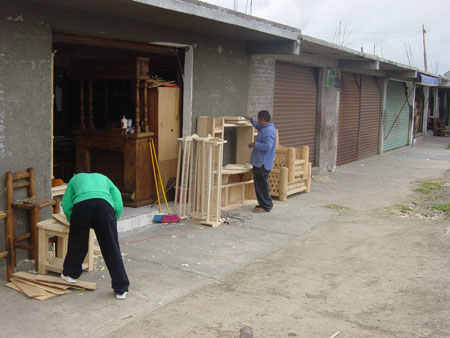 We
head for the toll booth, passing a row of buildings
where they’re building furniture by hand. Beautiful
dinning and bedroom sets of all different kinds of wood.
Some rustic, mostly elegant, classic pieces. We stop
for a brief moment to watch a craftsman hand plane his
work to perfection. We
head for the toll booth, passing a row of buildings
where they’re building furniture by hand. Beautiful
dinning and bedroom sets of all different kinds of wood.
Some rustic, mostly elegant, classic pieces. We stop
for a brief moment to watch a craftsman hand plane his
work to perfection.
We reach the toll booth and a man tells us the next
bus to Amecameca will arrive in 10 minutes. We pay our
8 pesos and ride the B.O. express to Amecameca. In one
of the constant contradictions we run across on this
trip, Randy decides to buy a handful of peanuts from
one of the vendors also riding the bus. Ten pesos earns
him a Dixie cup of Spanish peanuts and 8 pesos gets
us all the way to Amecameca.
Arriving in town, we decide that it’s too rainy
to try to go up to the mountain and check into the Hotel
San Carlos, the only hotel in town. The decision is
reinforced as we walk next door to get a permit to climb
tomorrow and learn that the roads leading into the Izta-Popo
National Park have been closed due to train at the lower
elevations and 15cm of snow higher up. They won’t
issue any permits today nor will the military allow
anyone to pass the checkpoints into the park”.
“Come back tomorrow”, they say. We got up
at 6am and raced here today to get to town by 1:30,
only to find out we have nothing to do. Further yet,
I don’t have a good feeling about tomorrow’s
weather either. If we can’t get on the mountain
tomorrow (day 7) and prepare to summit on day 8 we’ll
be done climbing.
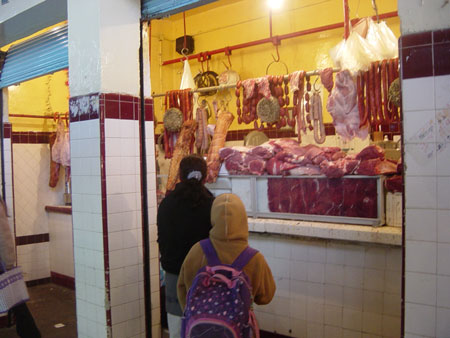 There’s
a huge market in the city square (Zocalo) where they
sell everything from packages of pink plastic hair curlers
to shoes and fresh poultry. The poultry is so fresh
I they’ve plucked the feathers and cut off their
heads this morning. They look just like rubber gag chickens
as we watch the man whack off the feet with a cling
of his knife. There’s
a huge market in the city square (Zocalo) where they
sell everything from packages of pink plastic hair curlers
to shoes and fresh poultry. The poultry is so fresh
I they’ve plucked the feathers and cut off their
heads this morning. They look just like rubber gag chickens
as we watch the man whack off the feet with a cling
of his knife.
We wander the market aimlessly, dodging rain falling
from the tarps covering each vendors stand. All I can
find is crap that nobody needs, and mountains of it,
but all I’m searching for is something handmade
for Kellie and the girls. Pink porcelain elephants,
pistachios, and Latin CD’s are everywhere why can’t
I find a blanket made with local textiles or anything
of any value.
All the stores in every town seem to have the same
junk. It’s like a 300 mile long flea market that
never closes. If they’re not selling crap or food
(why don’t these people weight 500 lbs.) they’re
got a weird specialty. Not one, but several stores in
each small town sell only wedding cakes or caskets.
It seems that nothing is painted, yet there are paint
stores everywhere. Another store is devoted to hair
coloring products. Every body is wearing a serape or
a colorful blanket over their shoulders, but where are
they buying them.
January 17, 2004
 We
wake on Day 7, our last chance to go up on Izta, to
find it’s raining even harder and the clouds are
even lower. I try to hang on to hope, but when the permit
office opens at 9:30, I realize that all is lost. We
hurriedly pack and get out of Amecameca not a moment
too soon. Under better conditions I might have enjoyed
the town. We
wake on Day 7, our last chance to go up on Izta, to
find it’s raining even harder and the clouds are
even lower. I try to hang on to hope, but when the permit
office opens at 9:30, I realize that all is lost. We
hurriedly pack and get out of Amecameca not a moment
too soon. Under better conditions I might have enjoyed
the town.
I try to call Kellie on the way out of town, but he
phones don’t seem to work suddenly. Our bus takes
us to the large bus station in Mexico City, TAPO. This
is our first visit to the heart of the big city and
it’s very foreign to us. After figuring out how
to pay for a taxi, we load into a small green and white
Isuzu driven by Javier.
When I tell him I wanted to go to the Hotel Lafayette,
he starts waving his hands saying “muy malo”.
After much discussion over price and safety, he takes
us to his recommended hotel. We pull up out front of
the Hotel San Madrid to be greeted by a doorman who
whisked away our luggage. To my surprise, Javier has
delivered us to a very nice place where we pay only
$60 per night, including breakfast.
Arriving at our room we immediately check for hot water
and the presence of toilet paper (and a seat…yes,
we’ve run across places where any one or all three
are missing). This morning’s “shower”
in Amecameca consisted of washing my hair in freezing
water in the sink and wiping the rest of my body down
with lemon baby wipes that we found in the Piedra Grande
hut.
It’s still early 1:30pm and after trying to change
our tickets with the travel agent in the hotel, unsuccessfully,
we decide to try to salvage the day with a tour of the
lost city of Teotihuacán.
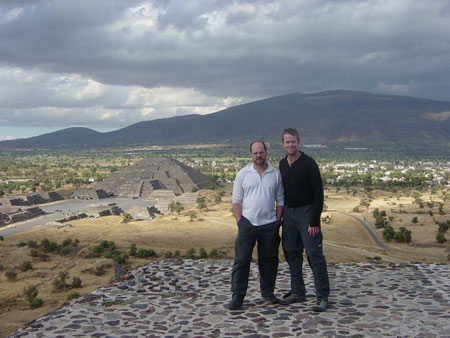 For
$25, a maniac driver races us at twice the posted speed
limit to tour this ancient area. For
$25, a maniac driver races us at twice the posted speed
limit to tour this ancient area.
During the drive, he eagerly points in every direction
and explains the history of the city, past and present.
At the pyramids he takes us to an artisan’s cooperative
where he undoubtedly receives a kickback for the visitors
he steers in their direction. Edwardo, our guide at
the cooperative, does an excellent job of explaining
the uses for the local cacti.
We learn that three different kinds of alcoholic beverages
are made from a cactus and we’re given samples
of each. The Pulque isn’t bad, but my first shots
of tequila though don’t leave me wanting more.
We watch artists weave blankets (finally!) from thread
made from the skin of a cactus and learned about rocks
and minerals, like shale and obsidian that are mined
locally. It took seven days of searching but I finally
found the handmade, locally produced gifts I had been
looking for. Bracelets of shale for Rachael and Sara,
and a shale and silver picture frame for Kellie, and
a blanket in the colors of our family room for all of
us.
After a running tour of the ancient Toltec city of
Teotihuacán, the second largest pyramids in the
world outside of Egypt, our group is herded back into
the van for a speedy run back to Mexico City and the
Basilica of Guadalupe. An unexpected side trip, the
Basilica was built in the 15th century and consists
of several churches built over the years. If find myself
to be quite interested in the legend of Guadalupe and
to watch people’s reverence as they pass through
the church. The Catholic faith plays a big role in Mexican
society.
The final thrill ride back to our hotel continues the
pattern of blown red lights, cutting off other drivers,
heading the wrong way on one way streets, and speeding
toward crossing pedestrians. As we pass through downtown
to unload other passengers, we see a hurdy-gurdy man
playing a box on a stick by means of a crank on the
side. With him are several minions in uniform collecting
money from stopped motorists. Randy thinks the money
must go to pay for the music lesions to turn that crank.
January 18, 2004
As the day began, we realize that we’re running
low on money, but we still have another night in the
hotel and a cab ride to the airport along with the evening’s
dinner. I stop at the desk to renew our room when I
notice a set of less expensive rates labeled “Uxmal.”
I learn that these rooms do not offer air conditioning
or breakfast and were smaller than our present location.
None of those were important to us and I attempted to
make the switch. To my surprise the workers at the desk
work with me to negotiate the Uxmal price, half of our
current rate, and still stay in the same room.
I’m quite pleased with this arrangement, now at
$35 including breakfast, until I receive a call from
the manager telling me I need to change rooms. I rush
downstairs proof in hand of my prior arrangement, to
correct the situation. This turned out to be my first
and hopefully only argument while in Mexico.
The woman who assisted me in the morning seemed to
have no recollection of our agreement. The manager insists
that they must have told me to change rooms. I had offered
three times to move to the less expensive Uxmal section,
only to be told it was not necessary. My final call
of the manager’s bluff came when he insisted that
he bellman recalled a different version of the arrangement,
an impossibility since the bellman was on a different
floor of the building. He finally acquiesced, realizing
that I had successfully disproved his argument I fully
expected to see an extra 300 peso charge on my bill
later for butter in the restaurant, just so they could
recover their cost.
 I
really wanted to go home today instead of drag through
Mexico City. We started the day with a visit to a local
church, San Hipolito. The past few days has spurred
my interest in the influence of the church and I am
interested in seeing a service as well as put in my
prayers for a quick return to my family. I
really wanted to go home today instead of drag through
Mexico City. We started the day with a visit to a local
church, San Hipolito. The past few days has spurred
my interest in the influence of the church and I am
interested in seeing a service as well as put in my
prayers for a quick return to my family.
The church is enormous and the crowd massive. The sign
outside indicates that there is a service nearly every
hour of the day on Sunday and several each weekday.
The building is packed with people sitting and standing
wherever they can find room. This is just a regular
Sunday and it’s much more crowded than even a Christmas
or Easter celebration at home.
Once again, the Mexican people’s devotion to the
church is inspiring. Many people hold lit candles, purchased
from the ever present vendors outside. Everyone blesses
themselves multiple times upon entering, exiting, sitting
or passing a stature of a saint. The church is immaculately
kept with ornate chandeliers paintings on the wall stretching
from floor to the ceiling over 50 feet tall and 20 feet
wide. Stained glass adorns the windows and statures
framed the gigantic alter area.
Our final full day in Mexico has us heading to the
famous National Museum of Anthropology. As we stroll
along the avenue of the reformas, we see neatly uniformed
police officers stationed by twos along every block.
Both impressive in the fact that the city took that
stance on crime, and disappointing that it was necessary.
On our way to the museum we see another set of street
performers, proving once again that not only will people
do anything for money, but that people will pay for
almost anything. This trio climbed on each others shoulders
and stacked three high walked through the stopped cars.
The top layer was a small child dressed in a dirty tiger
suit that would wave his arms and spin his tail to gain
attention. This went on for a minute until the tower
would collapse and they would scatter through the cars.
Meanwhile, the mother in the family would spend the
time during the show weaving through the cars selling
stuffed Winnie the Pooh dolls.
The hotel restaurant becomes the final nail in the
coffin for this day. We decide to celebrate the end
of a largely successful, although unfinished trip with
a steak dinner. In reality we want to find out what
$7.50 could buy in a steak. Randy orders the filet mignon,
which turned out to be one of his most succulent meals.
Mine however is quite possibly the worst pieces of steak
I’ve ever attempted to eat. When I enjoy the cauliflower
and carrots garnishing the steak even more, then the
meat itself, you know it’s bad.
I try to salvage it by ordering some extra sauce from
Randy’s filet, only to receive a plate of overcooked
bacon. Now I wanted some sauce for the bacon. I think
I’ll go home and learn the Spanish word for sauce.
Throughout the trip we’ve had some great food.
We did our best to experience the authentic flavor by
eating tamales wrapped in a Plantain leaf, purchased
from a street vendor in Amecameca. My most memorable
meal however, has to be the quesadillas we ate for lunch,
also in Amecameca. Cooked over a fire with tortillas
made in the market and chicken so fresh it had been
walking around someone’s backyard the day before.
Cooked just right and filled with cheese, they brought
a bit of sunshine to an otherwise cloud-filled day.
January 19, 2004
We’re on the airplane now heading home. Our last
hurrah came at the airport when the taxi driver dropped
us off. Already reeling from the fact that it cost three
times as much to go from the hotel to the airport as
it costs to go from the airport to the hotels, 150 pesos
vs. 45 pesos, we hop in the cab that the hotel doorman
hailed for us. I failed to confirm the hotel’s
published price with the driver only to learn upon arrival
that he wanted 250 pesos. I proceeded to discuss the
hotel’s price and his agreement to abide by that
already outrageous amount. He retuned by stating that
the hotel’s price is not his and that he sets the
amount. I firmly let him know that I was now setting
the price, gave him 150 pesos and left for the gate.
It wasn’t the way I wanted to end my Mexico experience.
The trip was great. I learned a lot, experienced the
culture, and proved to myself that I could organize
an international expedition.
Will I be back? The answer is a definite yes. I’m
not sure when yet, but I would like to experience the
summit of these two high peaks.
Vaya con Dios, Mexico
Hasta la Vista
Gracious por su hospitalidad
|